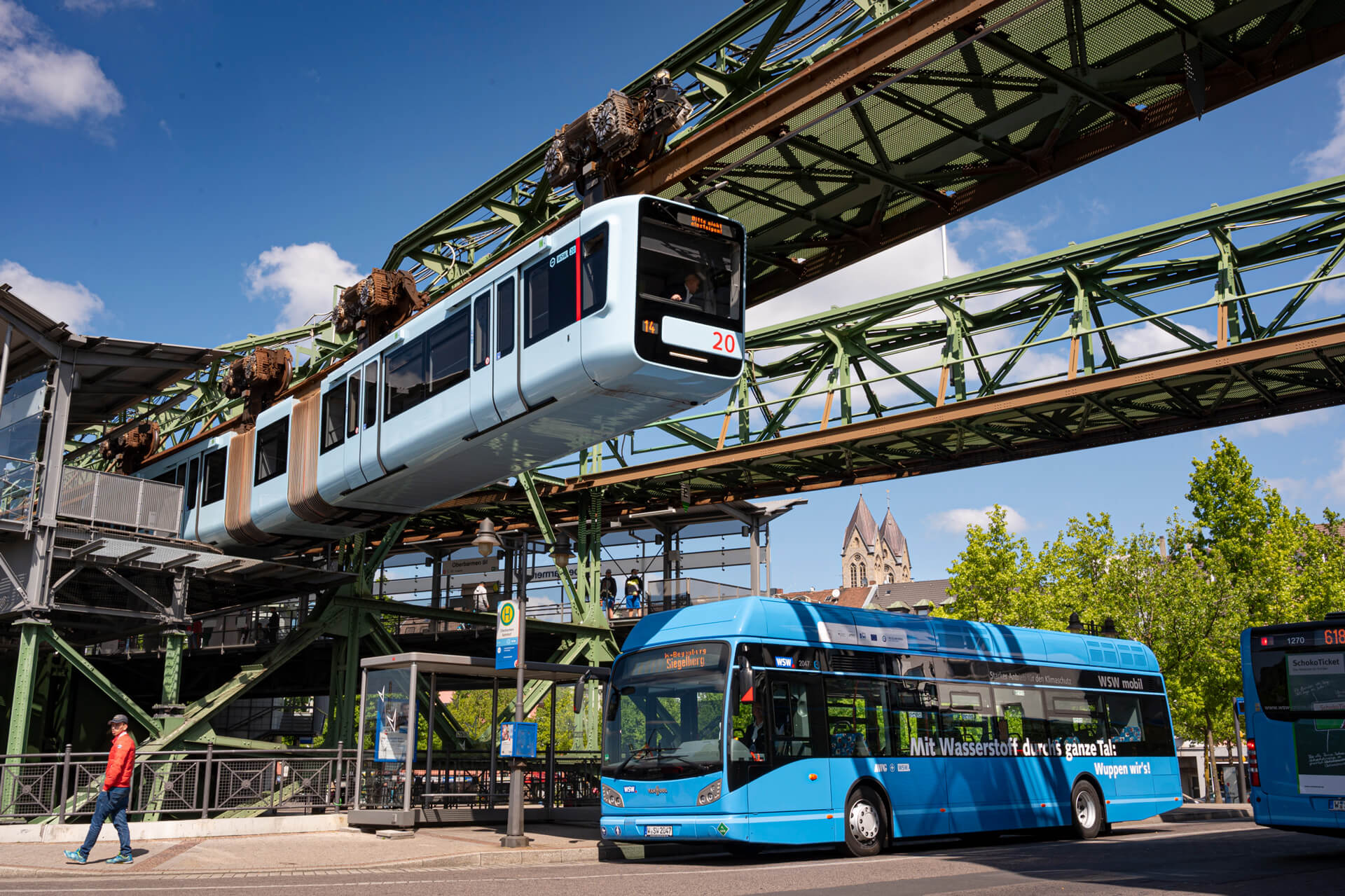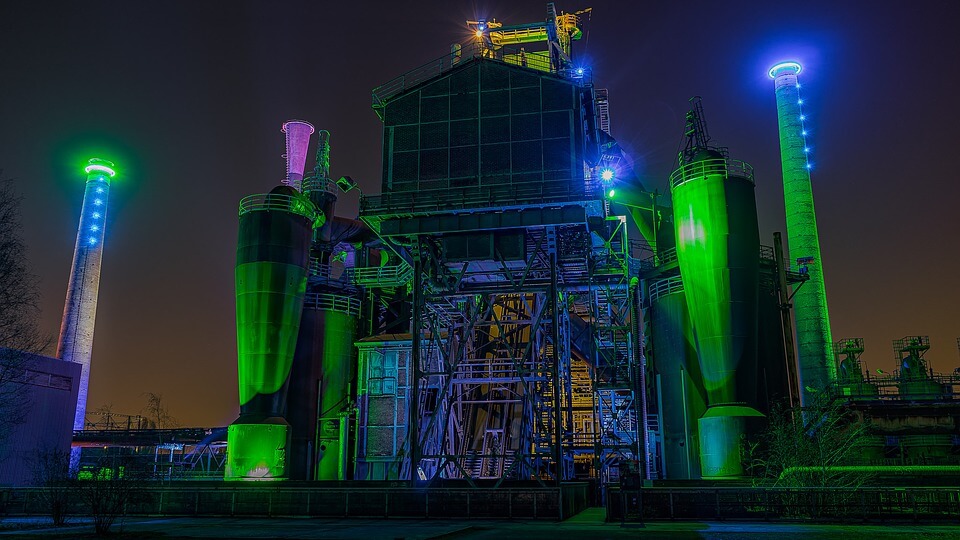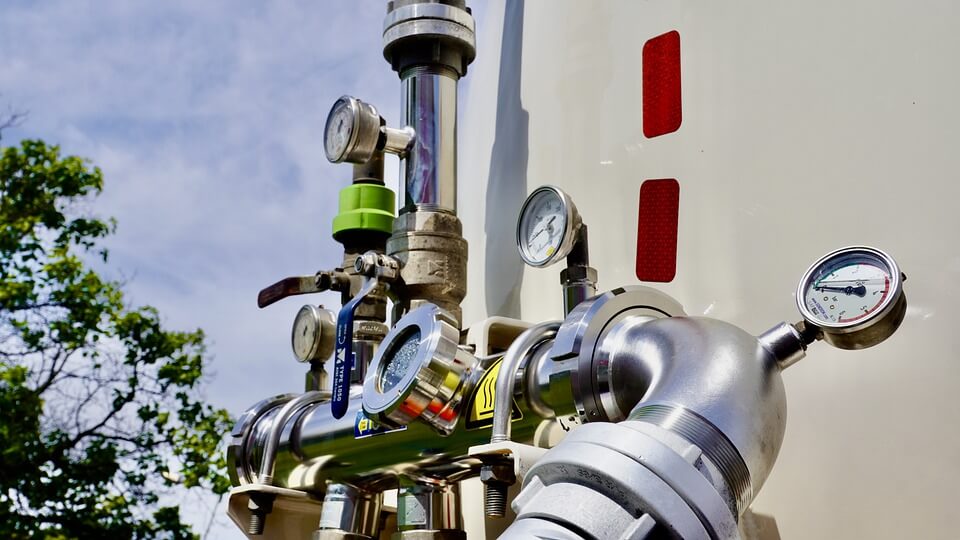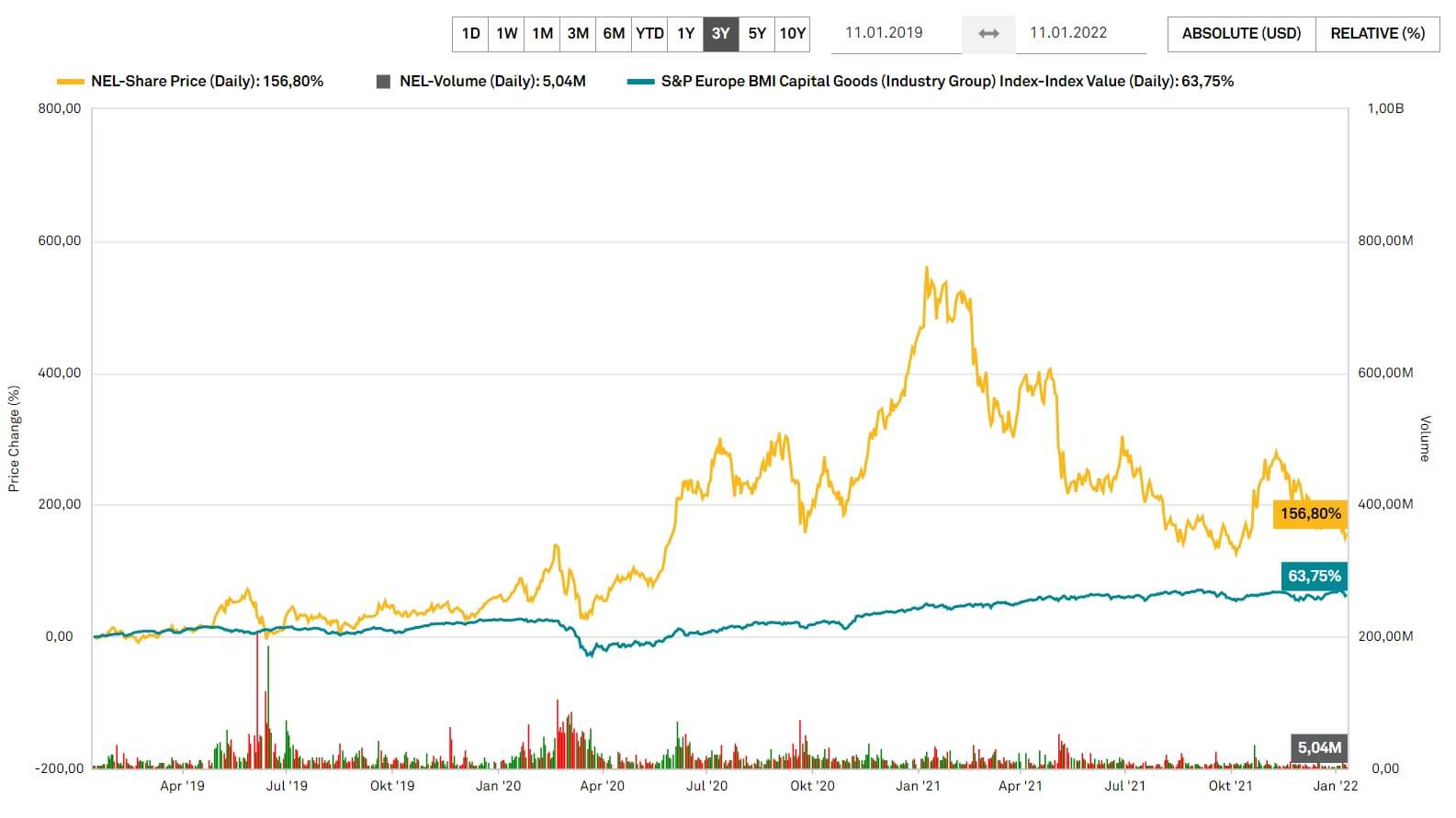
Time is running - climate protection targets 2050
With the Climate Protection Act passed in June 2021, Germany has tightened its climate targets. By 2030, CO2 emissions are to be reduced by 65% compared to 1990, by 2040 even by 88%. It was initially agreed to be greenhouse gas neutral by 2045, but the new government raised this target to 2050 in December 2021 due to unachievability. Germany thus intends to make its contribution to limiting global warming to well below 2 degrees and, if possible, to 1.5 degrees.
Achieving this goal will require a reduction in greenhouse gas emissions in almost all sectors. Many companies will have to change their energy supply. Alongside electricity from renewable energies, hydrogen in particular is seen as playing a key role in achieving the climate targets. In addition, hydrogen holds great value creation and export potential for the technology.
However, the past year 2021 was anything but successful for shares in the hydrogen and fuel cell sector. After a brilliant boom in the first half of the year, the signs pointed to a correction. However, in view of the energy transition and the importance of hydrogen technology, this sector in particular could experience a resurgence in the new year. Only recently, the German Federal Ministry of Economics, led by Green Party politician Robert Habeck, released EUR 900 million for the "H2Global" funding instrument.

Hydrogen - energy rich
The need for renewable energy sources is greater than ever. Society needs a sustainable system to replace fossil fuels with their CO2 emissions in the long term. With the National Hydrogen Strategy, Germany is creating a uniform framework for action for the future production, transport, use and further use of hydrogen and thus for corresponding innovations and investments. Hydrogen is considered the key element to replace fossil fuels in the long term.
As the most abundant chemical element in the universe, it is clean and readily available. Produced using renewable energies, so-called "green hydrogen", as a potentially CO2-free raw material, is gaining in importance worldwide. Whether as a raw material for industry, as a fuel for fuel cells or as a synthetic energy carrier - the potential applications are many and varied. The global business initiative Hydrogen Council, for example, estimates that the share of climate-neutrally produced hydrogen in final energy demand will rise from the current 2% to 18% in 2025.1
Fossil fuels are expendable?
Hydrogen and fuel cells have great potential to reduce dependence on petroleum imports, store energy to meet demand, and at the same time secure long-term value creation and jobs in the country of production. As recent studies have shown, fuel cell and hydrogen technology is on the cusp of greater commercialization. Some companies have established a good starting point to participate internationally in these growth markets.
"With our hydrogen strategy for Germany, we want to make green hydrogen marketable as an alternative, sustainable energy for the steel industry and in aviation, for example."
As fossil resources become scarcer, nuclear energy is phased out and international targets for reducing greenhouse gas emissions are set, the entire energy system is fundamentally changing and will be completely converted to renewable energy sources in the long term. Whereas in the past chemical energy sources dominated as primary energy sources, in the future they will be replaced in particular by electricity as a renewable, largely fluctuating primary energy. At the same time, however, the easy storage and transportability of energy will be partially lost. Intelligent linking of electricity, gas, heat and fuels for mobility is a prerequisite for a robust, sustainable and future-proof energy supply. Coordinated interaction between generation, transmission, distribution, storage and consumption of electrical energy enables efficient integration of renewables into the energy supply system as well as a safe transition into the regenerative energy age.
Industrialized countries need a robust and flexible energy strategy that can provide long-term planning security for all market players.
Electrolysers are thus the decisive key component of renewable hydrogen production. If the power-to-gas concept is to work on a large scale, powerful and cost-effective electrolysers must be available. That requires further research and development work, especially for dynamic operation with fluctuating energy sources. Significant cost reductions can be achieved, in particular, through series production as part of broad commercialization.
Hydrogen in the transport sector
The introduction of hydrogen as a fuel in the transport sector offers the opportunity to tap renewable energies in an even broader way for sustainable mobility based on electric drives, and thus to promote the energy transition. It requires a high degree of continuity in the development and market introduction both by industry in the development of materials, processes, components and systems and by politics in the continued support of this almost market-ready technology.

The introduction of the first series-produced vehicles by several manufacturers is imminent, and the last major producers should then debut on the market with their own fuel cell vehicles by 2025 at the latest. Since the refueling infrastructure requires a lead time, vehicle manufacturers and infrastructure developers must closely coordinate their market launch plans. In addition to the mass passenger car market, fuel cell drives for buses, special-purpose vehicles, cabs and other fleet vehicles in urban areas offer particular advantages that should be exploited to reduce pollutant and noise emissions in line with EU or regional regulations.
Fuel cell applications and energy systems
Stationary fuel cell applications range from domestic energy supply to emergency power generators and industrial energy supply. Their use increases energy efficiency through cogeneration. Corresponding fuel cells can be supplied with fossil energy sources as well as, in the future, with hydrogen. A major challenge is the further reduction of costs. The mass production of fuel cells for use in residential buildings, which has already been established in Japan through a market introduction program, is being used by German system suppliers in part through cooperation, although an adaptation for the national production of key components still needs to be made. Therefore, it is recommended to support the market introduction in home energy supply, which is currently starting in Germany, by a market incentive or market introduction program. 2

Hydrogen could disrupt steel industry - example ThyssenKrupp AG
ThyssenKrupp emitted 23 million tons of CO2 worldwide in 2019. 95% of these emissions are generated in steel production. "Ecologically" produced steel will continue to be needed by the economy in the future for light and affordable cars, for a functioning circular economy, as packaging material and as the basis for electric motors and wind turbines. That is why the use of hydrogen in the steel industry is a major lever for reducing CO2 emissions. One ton of hydrogen saves 25 tons of CO2 there. Decarbonization of the steel industry is one of the biggest fields of action for achieving climate targets worldwide and in Germany.
"For ThyssenKrupp, hydrogen is the key technology for making our industry fit for the future and sustainable."
While ThyssenKrupp is already converting CO2 produced in steel production in the Carbon2Chem® project, another technology is to ensure that CO2 is no longer produced in steel production in the first place. ThyssenKrupp plans to replace the carbon needed for the reduction of iron ore with hydrogen. Where CO2 is produced when coal is used, water is produced when hydrogen is used. The use of hydrogen in the blast furnace is also currently being tested. In this way, initial emissions can already be reduced in the existing plant structure. 3
Competition: hydrogen and fuel cell manufacturers
In the capital markets, hydrogen has been a hot topic since 2019. Nevertheless, the amount of relevant listed companies remains manageable. Basically, the group of industrial producers and resellers of hydrogen should be distinguished from fuel cell manufacturers. In this analysis, we focus primarily on the technology-oriented companies that significantly drive innovations in the fields of energy generation, mobility and climate protection.
In the field of electrolyser and fuel cell technology, Ballard Power, Fuelcell Energy, Plug Power, PowerCell Sweden, Hexagon Purus and Enapter belong to the peer group of Nel ASA. All companies have specific core competencies and occupy different commercial approaches in the industrial sector H2. In principle, the above-mentioned companies already have sales, although the high level of research and development work means that measurable profits rarely result. However, they are highly relevant in the international climate protection debate, as they bring hydrogen technologies to market maturity.
An overview of the current valuation ratios:
| Company (Country) | MCAP in Bio. EUR | Sales 2021e in Mio. EUR | Price-to-sales ratio (P/S ratio) | EBITDA 2021e in EUR million |
|---|---|---|---|---|
| Nel ASA (Norway) | 2,04 | 79,9 | 26,3 | -37,70 |
| Plug Power (USA) | 12,81 | 437,8 | 29,2 | -154,2 |
| Ballard Power (Canada) | 3,47 | 439,7 | 7,9 | -85,6 |
| Fuelcell Energy (USA) | 1,87 | 61,3 | 30,5 | -52,8 |
| PowerCell (Sweden) | 0,87 | 13,9 | 62,3 | -6,7 |
| Hexagon Purus (Norway) | 0,53 | 37,7 | 14,1 | -29,6 |
| Enapter (Germany) | 0,61 | 9,25 | 65,9 | -7,47 |
The overview shows that even the well-known market leaders are not yet operating in the profit zone. Based on the sales valuation for the year 2021, which has just been completed, the valuation band in the price/sales ratio ranges from 8 to 66, the arithmetic mean still calculates to 33.6. Nel ASA is in the middle of the range with a 25-fold sales valuation.
Company debt has not been included. According to available estimates, 2024 to 2026 will see the first companies break even. Therefore, for shareholders of hydrogen stocks, the investment will remain a hopeful gamble on individual breakthrough successes or large public investment programs for years to come. The H2 funding pots proclaimed by governments are insufficient to guarantee a permanent alimentation of the sales of the above-mentioned companies. The private sector must jump on this bandwagon, or the adoption of H2 technologies will fail due to Economics of Scale.
Nel ASA - The company at a glance
Nel ASA is a global hydrogen pioneer from Norway, providing solutions for the production, storage and distribution of hydrogen from renewable energy sources. The Norwegian group supplies industry, energy and gas companies with world-leading hydrogen technology. The company's roots date back to 1927, and in recent years the development and continuous improvement of hydrogen technologies has been driven forward. Today, Nel hydrogen solutions cover the entire value chain, from hydrogen production to relevant technologies and physical hydrogen refueling stations. They enable the industry to transition to green hydrogen and provide fast refueling for all fuel cell electric vehicles.
"We deliver optimal solutions to produce, store, and distribute hydrogen from renewable energy."
Today, Nel ASA is headquartered in Oslo. As early as 1927, Nel installed the first small electrolyser at Norsk Hydro for fertilizer production. In 1953, the second largest electrolyser factory was started for the production of hydrogen in ammonia production in Glomfjord, Norway. Then in 2001, Nel unveiled the first commercial pressurized electrolyser. With the IPO in 2014, Nel ASA became the first pure hydrogen company with a listing on the Oslo Stock Exchange.
The group has also included the Danish hydrogen filling station manufacturer H2 Logic since 2015 and the American electrolysis specialist Proton OnSite since 2017. Together with the companies PowerCell Sweden and Hexagon Composite, Nel founded the joint venture Hyon in September 2017, which aimed to establish fuel cell-powered vehicles, particularly in the maritime sector. After Hexagon Composite and PowerCell later withdrew from Hyon, it was replaced by a new joint venture with Norwegian Hydrogen and Saga Pure.
Within the Group, the subsidiary Nel Hydrogen US operates in the North American market. The Nel Hydrogen fueling business unit builds hydrogen fueling stations and dispensers. Nel has been part of the Europe-wide H2 bus consortium since June 2019. The goal is to deploy at least 1,000 hydrogen fuel cell buses in Europe, primarily in public transport.

Own fuel cell electric vehicles are also being designed. Vehicles powered by hydrogen already achieve similar ranges to internal combustion engines. They do not have the associated emissions. Nel ASA is committed to reducing the price of green hydrogen per kilogram to $1.50 by 2025. To achieve this, Nel is making massive investments and accepting a negative operating result over the next five years. However, this is necessary to maintain leadership.
According to an agreement between Nel ASA and Everfuel A/S dated November 25, 2020, Everfuel and Nel have agreed to jointly establish a joint venture to develop the hydrogen fuel market for residential and truck customers in Norway. Everfuel will acquire 51% of the shares in H2FuelNorway AS (H2Fuel), which has been renamed Everfuel Norway Retail AS as of early 2021. Nel will hold the remaining 49% of the shares. Everfuel A/S is a 2019 Nel investment in the form of a hydrogen refueling station network that will supply hydrogen to Europe in addition to Norway. The station in Hvam (northeast of Oslo) became operational as the first of two refueling sites in November 2020. This milestone can be seen as the starting point for the commercial implementation of green hydrogen refueling.
NEL share performance
Nel ASA steadily increased its revenue from 489 to 652 million Norwegian kroner (NOK/EUR 9.97) in 2018 to 2020. However, due to strong investments, EBIT always remained in negative territory, and the loss even successively increased from -132 to -255 million NOK. In the third quarter of 2021, sales already rose to NOK 229 million (+55% y-o-y), while EBITDA was still negative at NOK -113 million. Strong demand remained for the "H2StationTM" hydrogen refueling stations as well as the PEM electrolysers. A cooperation in the field of energy generation and storage was established with the German SFC Energy. Through several capital increases, Nel ASA expanded its cash position to over NOK 2.9 billion by the end of Q3-2021. This means that the cash position can be described as very comfortable. The 2021 full-year results are expected on February 17, 2022.
On the investment side, impairment charges at Nikola Corp. and Everfuel resulted in impairment write-downs of NOK 67.4 million and NOK 311.2 million, respectively. The increasing size of projects also entails increased working capital requirements. The personnel side was adjusted in line with necessities due to the high order intake. The ramp-up in Heroya incurred operating costs without any sales being recognized to date. The integration of new product areas, consumer segments and technical components is continuously increasing costs.
The 3rd quarter was again negatively impacted by COVID-19, preventing some employees from traveling and increasing the workload of local employees. The order book remains well filled. At the end of the quarter, open orders totaled NOK 1.014 billion - up 8% y-o-y.
| Nel ASA in EUR million | 2020 | 2021e | 2022e | 2023e |
|---|---|---|---|---|
| Sales | 53,99 | 79,91 | 116,58 | 189,25 |
| Gross margin % | 31,9 | 34,3 | 35,1 | 37,7 |
| EBITDA | -26,2 | -37,7 | -28,2 | -8,0 |
| EBIT | -33,4 | -49,6 | -43,1 | -26,4 |
| Free Cashflow | -30,4 | -90,6 | -65,7 | -54,8 |
| Net profit / *including special effect | 117,82* | -131,1 | -42,2 | -26,7 |
| Earnings per share (EPS) in EUR | 0,08* | -0,09 | -0,03 | -0,02 |
| Book value per share (BVPV) in EUR | 0,29 | 0,35 | 0,32 | 0,30 |
| Price-to-sales ratio (MCAP/Sales) | 38,9 | 26,3 | 18,1 | 11,1 |
Analysts polled by S&P expect a good doubling of current sales volumes to the equivalent of EUR 189 million by 2023. It should be possible to increase the gross margin from 32% to just under 38% in the said period. No free cash flow is expected in any year, and net results will also remain negative (exception: year 2020 due to a special effect). A reduction in losses expected by investors is likely to be further delayed. The above figures in euros vary with the volatility of the Norwegian Krone, which has been as high as 7% per annum in recent years.
SWOT analysis
Strengths
- First mover in the hydrogen market with the construction of the first electrolyser
- Strong capitalization creates flexibility in order size
- High reputation due to long company tradition
- Good access to technical personnel and academics in Scandinavia
Weaknesses
- Strong competition in Europe and the USA
- Growing competition in the field of hydrogen refueling stations
- Dependence on public funding
Opportunities
- Strong political support for the hydrogen economy
- Good history and optimal size for more capital-intensive projects
- Fast realization of orders due to high degree of networking in the industry
Threats
- Delays and competition in obtaining public tenders
- Increasing working capital requirements puts pressure on margins
- Alternative forms of energy could displace the rather expensive hydrogen
Outlook: New Executive Board
The most recent background to the continuing share price weakness of Nel ASA may have been the appointment of Håkon Volldal as the new Chief Executive Officer (CEO) announced on January 6, 2022. His predecessor, Jon André Løkke, who was highly respected in professional circles, had already made this office available in the middle of last year in the environment of the massive share correction at the time in order to turn to new challenges. However, the actual operational handover from Løkke to Volldal was not scheduled to take place until the second quarter of 2022, but this did not happen.
"Our vision at Nel is to 'power generations with clean energy forever'. Our technology enables people and businesses to use hydrogen, the most abundant element in the universe, in everyday life."
While Løkke's successful work in building Nel ASA into one of the world's pioneers in hydrogen technologies was preceded by an equally innovative career in the technology and energy industries, Volldal's main focus up to now has been on logistics at Q-Free ASA and the deposit machine giant Tomra Systems. One could deduce from this that under Volldal's future CEO leadership, Nel ASA's strategic focus could shift more strongly from Løkke's important and undoubted domain in direct hydrogen production technologies to the downstream area of storage and transport of its produced hydrogen. However, if this logistical stage of the value chain is emphasized, this is likely to be an additional advantage in the future only if the continuous technological and, above all, profit-enhancing developments of their hydrogen production are not neglected. So far, the production of green hydrogen has not yet yielded any operating profits. The long-term experiment to sustainable profitability would thus be a development stage reserved for the new CEO Håkon Volldal.4
Conclusion - Looking ahead
The three-year performance of the Nel ASA share compared to the BMI Capital Goods EUR Index Value (Daily) shows a relative outperformance of 118.6% over a 3-year period. However, after the hype movement from November 2020 to February 2021, it reveals a relative underperformance in 2021 due to a strong price correction, which however affected the entire sector.

With the supply of the passenger car industry and battery vehicles, countries worldwide are facing enormous challenges. It is questionable whether sufficient electricity can be made available on a permanent basis. Thus, a considerable part of mobility and transportation must be supplied with other energy sources. Hydrogen will play a central role here. The time is ripe to push ahead with a potential contribution by hydrogen in a sustainable energy system. Like other green technologies, hydrogen will therefore be essential to achieving a 'net zero emissions' energy system by 2050.
In the case of Nel ASA, we are dealing with a developer of hydrogen technologies and associated distribution systems that has been actively engaged in research for a number of years. For its interim successes, the stock market is already prepared to call up very high valuations. After all, shareholders of the Oslo-based company still have to wait at least four years for a dividend payout. The share is currently trading at a market capitalization of 25 times sales in 2021. The near future will have to show whether Nel ASA can meet the existing demand on the market with its commercial approaches. Refinancing via the stock exchange is probably possible at any time in a positive market environment, so the company can continue to grow unhindered. One of the decisive factors for long-term success is the global political course set in favor of a hydrogen technology subsidy similar to the measures already active in e-mobility.
As an accompanying risk aspect, the point of low interest rates on central bank funds since 2015 must be included in the analysis. Growth capital is currently still being provided at virtually zero cost. But at the turn of the year, the US Federal Reserve announced a gradual exit from its bond-buying program. However, the dramatic inflation trend in 2021, with rates in some cases doubling y-o-y, is sending massive warning signs in the direction of growth markets, especially in the area of highly valued technology stocks.
Under these circumstances, it can be assumed that a positive performance for Nel ASA can only be expected in the presence of sufficient market liquidity and easy access to growth capital. Nel ASA will not be able to decouple much from the industry trend, but as a successful standard stock and industry leader, its outperformance relative to its peer group should be maintained - in good times and bad. However, in a rising interest rate environment, the normalization of valuation parameters across the sector could take some time.

